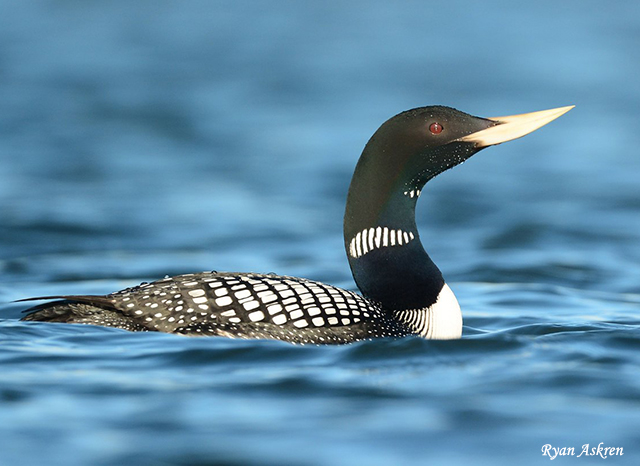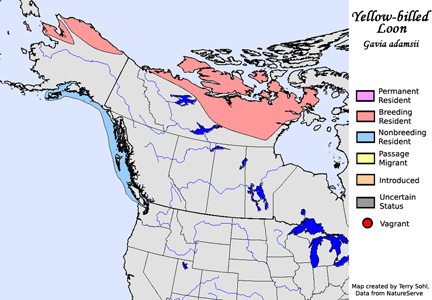| Length: 35 inches | Wingspan: 45 to 50 inches | Seasonality: Accidental Visitor |
| ID Keys: Largest of the loons, thick heavy pale bill, thick neck. Similar to Common Loon in plumage. | ||
 The
Yellow-billed Loon is the largest of the loons, resembling a
Common Loon in plumage but obviously
larger and more heavily built. They are truly a bird of the north,
breeding further north than the other commonly found loons in North America.
In winter, the majority of birds are found in the north Pacific. Only
a few are found as far south as the lower 48 states, and nearly all of those
along the Pacific Coast. Increasingly, however, single birds have been
spotted wintering in the interior of North America. The species was
unknown in South Dakota until a single bird was spotted below Fort Randall
Dam in December 2008. the photo to the right represents a bird in
winter plumage.
The
Yellow-billed Loon is the largest of the loons, resembling a
Common Loon in plumage but obviously
larger and more heavily built. They are truly a bird of the north,
breeding further north than the other commonly found loons in North America.
In winter, the majority of birds are found in the north Pacific. Only
a few are found as far south as the lower 48 states, and nearly all of those
along the Pacific Coast. Increasingly, however, single birds have been
spotted wintering in the interior of North America. The species was
unknown in South Dakota until a single bird was spotted below Fort Randall
Dam in December 2008. the photo to the right represents a bird in
winter plumage.
Habitat: Breeding grounds are the high Arctic tundra. Usually winters on the ocean, often near islands, in bays, or other semi-protected areas. A very few may winter on large lakes and reservoirs in the interior of the continent.
Diet: Probably feeds primarily on fish, although the diet of the species is poorly understood. There are some indications that fledgling will also feed on some plant material.
Behavior: Feeds as do other loons, by diving below the water's surface and swimming underwater in pursuit of prey, propelled primarily by their feet.
Breeding: Non-breeder in South Dakota
Song: Similar yodeling or wailing to a Common Loon, but slower, deeper-pitched, and more coarse.
Migration: Summers in the high Arctic. Most winter in the North Pacific, with just a very few birds wintering in the interior of the continent.
Interactive eBird map: Click here to access an interactive eBird map of Yellow Loon sightings
Similar Species: Common Loon
Conservation Status: Worldwide population is likely only 10,000 or less. Although the breeding grounds are far from most human disturbance, the low total population makes the species potentially vulnerable to a large oil spill or natural disaster. Given population declines in recent years, the IUCN considers the Yellow-billed Loon to be a "Near Threatened" species.
Further Information: 1) BirdWeb - Yellow-billed Loon
2) Audubon Field Guide - Yellow-billed Loon
3) Whatbird: Yellow-billed Loon
Photo Information: Photo taken by Ryan Askren - August 12th, 2013 - Bering Land Bridge National Preserve, Alaska
| Click on the map below for a higher-resolution view |
 |
| South Dakota Status: Rarely found inland in the lower 48 states, and unknown in South Dakota until a single bird was found in December 2008. There are sight records from several surrounding states as well, however, indicating that the species may be seen again in South Dakota. |
Additional Yellow-billed Loon Photos (coming soon!)
